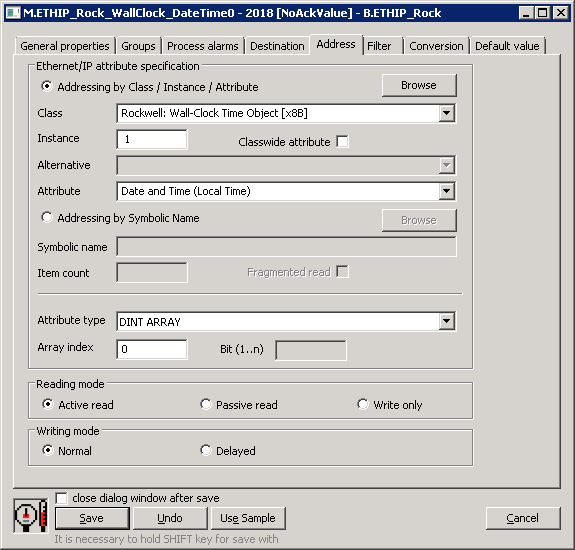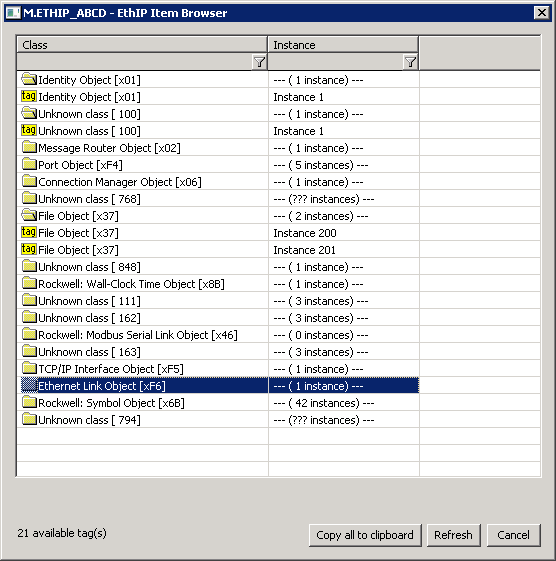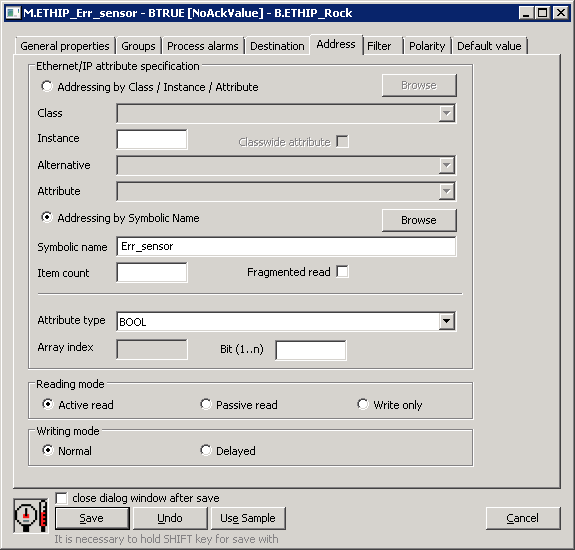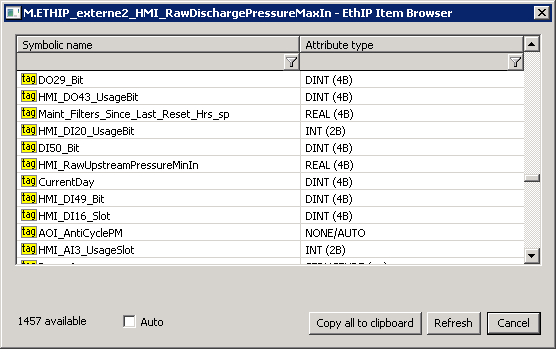Supported device types and versions
Communication line configuration
Communication line protocol parameters
Communication station configuration
Station protocol parameters
I/O tag configuration
Literature
Changes and modifications
Document revisions
| Kotva | ||||
|---|---|---|---|---|
|
...
The communication was tested against:
- Allen-Bradley
...
- Micro820
- 1769 CompactLogix 5370
...
- Controller (1769-L18ER/A)
- ControlLogix EtherNet/IP bridge Module (1756-EN2TR/C) connected to 1756-L85E ControlLogix 5580 Controller (1756-L85E/B)
Note: The Micro820 firmware version 6 only partially supported work with symbol addresses. Reading and writing worked, but browsing didn't - there was no class Symbol Object [0x6b]. Firmware version 10.0.12 supported browsing.
Note: CompactLogix 5370 supported work with symbol addresses, browsing as well as optimization of work in symbolic mode using Symbol Instance ID.
...
- Communication protocol: Ethernet/IP.
- Station address is not configured. Multiple stations may be configured on a single line (e.g. because of different time parameters of individual stations).
| Kotva |
|---|
...
|
...
|
...
Possible value types of I/O tag: Di, Ai, Ci, TxtI, TiR, TiA, Dout, Ao, Co, TxtO, ToR, ToA
The addressing of I/O tag can be either standard or symbolic (Rockwell).
Standard addressing - Addressing by Class / Instance / Attribute
This addressing method uses messages defined by the CIP standard:
- Get_Attribute_Single [0x0E]
- Set_Attribute_Single [0x10]
Within these messages, an item is addressed by the class number (Class), the instances within the class (Instance) and the attribute number of the particular instance (Attribute).
...
Symbolic Addressing - Addressing by Symbolic Name
This addressing method is supported for Rockwell devices. It uses Proprietary Rockwell messages:
- Read Tag Service [0x4C]
- Write Tag Service [0x4D]
- Read Tag Fragmented Service [0x52]
- Write Tag Fragmented Service [0x53]
While browsing the proprietary Rockwell message Get Instance Attribute List [0x55] is used. Some devices or firmware versions do not support this message or the Symbol Object [0x6b] class that the message uses.
...
|
...
Communication station - configuration dialog box - tab Protocol parameters.
These parameters influence some optional parameters of protocol. You can set the following station parameters:
Table 2
| Parameter | Meaning | Unit / size | Default value | ||||||
|---|---|---|---|---|---|---|---|---|---|
| An octet string representing the parameter Route_Path (of padded EPATH type, that is, the number of octets must be even). If this parameter is specified, the protocol messages (Get_Attribute_Single, Set_Attribute_Single, Read Tag [Fragmented] Service, Write Tag [Fragmented] Service) will be wrapped in an Unconnected Send message that is used for routing. It was not necessary to change this parameter when communicating with Micro820 and CompactLogix devices. When communicating with ControlLogix via the ControlLogix EtherNet/IP bridge Module (1756-EN2TR/C), it was necessary to set the parameter to 01 00, which according to protocol documentation means Port 1 (which represents the backplane) and slot 0 (where the Central Processor was located). To communicate with the processor in slot 1, the parameter had to be set to 01 01, so the general syntax for accessing a slot XX would be 01 XX. | octet string | |||||||
| Setting the parameter to YES causes the protocol messages (Get_Attribute_Single, Set_Attribute_Single, Read Tag [Fragmented] Service, Write Tag [Fragmented] Service) to be packaged in a Multiple Service Packet Service message. In the future, this parameter can be used for communication optimisation (wrapping multiple messages into one), in the current implementation, each message is packaged separately, therefore we recomment not to use this parameter. | YES/NO | NO |
| Kotva | ||||
|---|---|---|---|---|
|
...
Possible value types of I/O tag: Di, Ai, Ci, TxtI, TiR, TiA, Dout, Ao, Co, TxtO, ToR, ToA
The addressing of I/O tag can be either standard or symbolic (Rockwell).
Standard addressing - Addressing by Class / Instance / Attribute
This addressing method uses messages defined by the CIP standard:
- Get_Attribute_Single [0x0E]
- Set_Attribute_Single [0x10]
Within these messages, an item is addressed by the class number (Class), the instances within the class (Instance) and the attribute number of the particular instance (Attribute).
| Kotva | ||||
|---|---|---|---|---|
|
| Kotva | ||||
|---|---|---|---|---|
|
| Kotva | ||||
|---|---|---|---|---|
|
| Kotva | ||||
|---|---|---|---|---|
|
| Kotva | ||||
|---|---|---|---|---|
|
By clicking the Browse button, a browse dialog can be opened and a list of classes and instances within the class can be retrieved as long as the communication with the device is established. When opening, only a list of classes (rows with folder icon) are read for speed reasons. Double-click on a class retrieves a list of instances (if the number of instances was determined, i.e. it is not zero or unknown - "???"). Double-clicking on a specific instance (lines with the tag icon) copies the class and the instance to the configuration dialog of I/O tag.
Note 1: the number of actually retrieved class instances may be less than the number displayed within the list of classes.
Note 2: browsing attempts to read all instances of 1 .. Max Instance, where Max Instance is detected when reading a list of classes. However, if Max Instance > 1000, only the first 1000 instances are tested during browsing. Reading of all instances can take up to several tens of seconds. When it is finished, the folder icon is changed from closed to open.
Note 3: In versions from 20th December 2018 and newer, recycling of browser dialog has been implemented. If the dialog is closed by the Close button or after selecting an instance, it is actually only hidden and it is available for browsing by another I/O tag within the same station so that the tree structure of the browsed objects is preserved. Clicking on the close icon at the top right corner will cause the dialog to be really closed.
The Refresh button is used to repeatedly retrieve the list from the device. The KOM process caches a list of classes and instances, so the second and subsequent opening of the browse dialog or reading of the list of instances for a specific class is significantly faster than the first one during which the data is being read from the device.
Symbolic Addressing - Addressing by Symbolic Name
This addressing method is supported for Rockwell devices. It uses Proprietary Rockwell messages:
- Read Tag Service [0x4C]
- Write Tag Service [0x4D]
- Read Tag Fragmented Service [0x52]
- Write Tag Fragmented Service [0x53]
While browsing the proprietary Rockwell message Get Instance Attribute List [0x55] is used. Some devices or firmware versions do not support this message or the Symbol Object [0x6b] class that the message uses.
Symbolic name - a symbolic name. It can be simple (Test) or contain the address of a specific item of one-dimensional array (Test [3]), multidimensional (Test [1] [2]), item of a structure (Test.MyItem1) or item of array of structures (Test[2].MyItem1).Kotva symbolic_name symbolic_name
Item count - number of elements in the case of array of values.This number may be less than or equal to the actual size of array in the device.If it is not specified, one element is read.Kotva item_count item_count
Fragmented read - indicationthat the Read Tag Fragmented Service message should be used for reading, because the entire array does not fit into a message with the length specified by the Max Packet Size parameter.
Note: If the reading using Read Tag Service message returns an error code Partial Transfer [0x06], next reads will use the Read Tag Fragmented Service message as if the Fragmented read indication was set.
By clicking the Browse button, a browse dialog can be opened and a list of symbolic names retrieved as long as the communication with the device is established. For each symbolic name its type is also read. In the case of structures or arrays of structures, the type is identified as "STRUCTURE (---)". D2000 cannot presently use such complex types - it is necessary to specify an address of a particular item as a symbolic name (e.g. MyStruct.MyItem or MyArr [1] .MyItem).
The Auto option is used to set the NONE/AUTO attribute type (autodetect). If this option is off, the attribute type is copied to the I/O tag along with the symbolic name after double-click on a specific line in the list of symbolic names.
The Refresh button is used to repeatedly retrieve the list from the device. The KOM process caches a list of symbolic names, so the second and subsequent opening of the browse dialog is significantly faster than the first one during which the data is being read from the device.
Note: symbolic names beginning with the underscore are related to system objects of Rockwell device, other names are user defined.
Atribute type - type of attribute. In case of standard addressing, it is necessary to enter a specific type. In case of symbolic addressing, it is possible to leave the type of the attribute as NONE/AUTO (autodetect), since proprietary Rockwell messages contain both the value and the attribute type. An exception is if the I/O tag is write only - then the attribute type must be specified.
Note: not all types of attributes from the offered list have read/write implemented. All numeric types, time types, strings (SHORT_STRING, STRING, STRING2) and numeric and time array types are supported. International string (STRINGI) type is supported for reading.
Array index - index of an element in array, if the attribute is an array. In Ethernet/IP protocol, an array is indexed from zero, so if Item count is equal to 3, indices 0, 1 and 2 are allowed.
Note: if Array index + 1> Item count, then Array index + 1 element will be read instead of Item count.
Bit (1..n) - if an attribute type is unsigned number (BOOL, USINT, UINT, UDINT, ULINT, DATE, TIME_OF_DAY, BYTE, WORD, DWORD, LWORD, ENGUNIT and arrays of these types) it is possible to enter a specific bit (1 to 64, depending on the number of bits for a specific type).
Reading mode - a way to read the I/O tag. There are three ways of reading:
- Active read - the I/O tag generates read requests.
- Passive read - the I/O tag does not generate read requests, but it processes values read by another I/O tag with the same Class/Instance/Attribute address or Symbolic name. This mode makes sense for reading arrays, where a single I/O tag can be active and the other I/O tags are passive, so values of all (or selected) array items are read with one request.
Note: the Ethernet/IP protocol supports the reading of arrays into the structure (Target tab), so it is possible to read the entire array into the column of a structure using a single I/O tag. - Write only - the I/O tag is intended only for writing.
Writing mode - a way of writing the I/O tag. This parameter only applies to output I/O tags (Dout, Ao, Co, TxtO, ToR, ToA).
- Normal - writing to the I/O tag will cause the write request to be sent.
- Delayed - writing to the I/O tag will be deferred and executed only as part of the writing of another I/O tag with the same Class/Instance/Attribute address or Symbolic name.This mode makes sense for writing to arrays, when multiple array elements are written using deferred I/O tags, and then writing to a Normal I/O tag generates a single request to write a complete array.
Note 1: if it is necessary to read the entire array MY_ARR (to the target structure or to multiple I/O tags), it can be done by a single read request (unless the array is too large). Set in the first I/O tag configuration:
- Symbolic name: MY_ARR
- Item_count: number of array items (e.g. 10)
- Array index: not specified or 0
- Reading mode: leave as Active read
The first array item (with index 0) is read into this I/O tag. To read an array into a structure, specify the Destination column parameter in the Destination tab. To read array items into other I/O tags, configure them as follows:
- Symbolic name: MY_ARR
- Item_count: not specified
- Array index: 1 to 9
- Reading mode: change to Passive read
Note 2: When working with the ControlLogix 5580 Controller, there was a need to read multidimensional arrays. The MY_ARR field had dimensions [0..7] [0..3] [0..23]. Settings for reading an array (always 24 values at once) in the first I/O tag configuration:
- Symbolic name: MY_ARR[1][2][0] (for reading indices [1][2][0..23])
- Item_count: 24
- Array index: not specified
- Reading mode: Active read
Settings for I/O tags 1 to 23:
- Symbolic name: MY_ARR[1][2][0] (i.e. the same as for 0-item)
- Item_count: not specified
- Array index: 1 to 23
- Reading mode: change to Passive read
The Symbolic name had to contain all three indices, i.e. specification MY_ARR[1][2] didn't work
By clicking the Browse button, a browse dialog can be opened and a list of symbolic names retrieved as long as the communication with the device is established. For each symbolic name its type is also read. In the case of structures or arrays of structures, the type is identified as "STRUCTURE (---)". D2000 cannot presently use such complex types - it is necessary to specify an address of a particular item as a symbolic name (e.g. MyStruct.MyItem or MyArr [1] .MyItem).
The Auto option is used to set the NONE/AUTO attribute type (autodetect). If this option is off, the attribute type is copied to the I/O tag along with the symbolic name after double-click on a specific line in the list of symbolic names.
The Refresh button is used to repeatedly retrieve the list from the device. The KOM process caches a list of symbolic names, so the second and subsequent opening of the browse dialog is significantly faster than the first one during which the data is being read from the device.
Note: symbolic names beginning with the underscore are related to system objects of Rockwell device, other names are user defined.
Atribute type - type of attribute. In case of standard addressing, it is necessary to enter a specific type. In case of symbolic addressing, it is possible to leave the type of the attribute as NONE/AUTO (autodetect), since proprietary Rockwell messages contain both the value and the attribute type. An exception is if the I/O tag is write only - then the attribute type must be specified.
Note: not all types of attributes from the offered list have read/write implemented. All numeric types, time types, strings (SHORT_STRING, STRING, STRING2) and numeric and time array types are supported. International string (STRINGI) type is supported for reading.
Array index - index of an element in array, if the attribute is an array. In Ethernet/IP protocol, an array is indexed from zero, so if Item count is equal to 3, indices 0, 1 and 2 are allowed.
Note: if Array index + 1> Item count, then Array index + 1 element will be read instead of Item count.
Bit (1..n) - if an attribute type is unsigned number (BOOL, USINT, UINT, UDINT, ULINT, DATE, TIME_OF_DAY, BYTE, WORD, DWORD, LWORD, ENGUNIT and arrays of these types) it is possible to enter a specific bit (1 to 64, depending on the number of bits for a specific type).
Reading mode - a way to read the I/O tag. There are three ways of reading:
...
Writing mode - a way of writing the I/O tag. This parameter only applies to output I/O tags (Dout, Ao, Co, TxtO, ToR, ToA).
...
.
Kotva literatura literatura
Literature
| literatura | |
| literatura |
...
RSLogix 500 Getting Results Guide, Rockwell Automation
| Info | ||
|---|---|---|
| ||
You can read blogs about Ethernet/IP protocol: |
| Kotva | ||||
|---|---|---|---|---|
|
...



